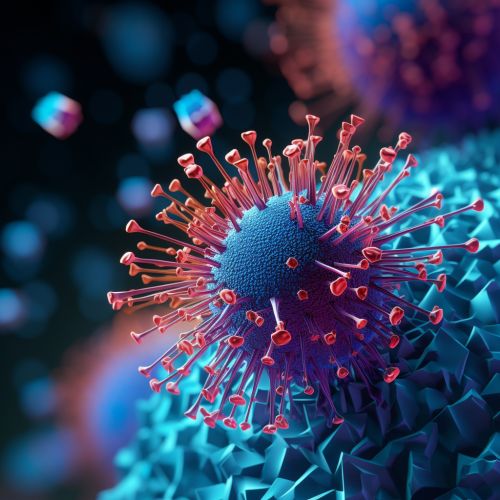Respiratory syncytial virus
Overview
Respiratory syncytial virus (RSV) is a common, contagious virus that causes infections of the respiratory tract. It is the most common cause of bronchiolitis and pneumonia in children under 1 year of age in the United States. Although it is often mild for adults, RSV can be severe in young children, older adults, and people with weakened immune systems.


Virology
RSV is a member of the Paramyxoviridae family and the Pneumoviridae subfamily. It is a negative-sense, single-stranded RNA virus. The virus is approximately 150 nm in diameter and has a lipid envelope. There are two antigenic subgroups of the virus, A and B, which can co-circulate and cause epidemics.
Transmission
RSV is primarily spread through respiratory droplets when a person with the virus coughs or sneezes. It can also spread by direct contact with the virus, such as touching a contaminated surface and then touching the eyes, nose, or mouth. The virus can survive on hard surfaces for many hours. RSV infections often occur in epidemics that last from late fall through early spring.
Clinical Manifestations
RSV infection can cause a variety of symptoms, ranging from mild cold-like symptoms to severe pneumonia. Symptoms usually appear 4 to 6 days after exposure to the virus. In adults and older children, RSV usually causes mild cold-like symptoms, including a runny nose, decrease in appetite, coughing, sneezing, fever, and wheezing. In severe cases, it can cause more serious symptoms such as high fever, severe cough, wheezing, rapid breathing or difficulty breathing, bluish color of the skin due to lack of oxygen, and chest pain or tightness.
Diagnosis
Diagnosis of RSV infection is usually based on the patient's clinical symptoms and medical history. Laboratory testing can confirm the diagnosis. The most common method of laboratory diagnosis is the detection of viral antigens in respiratory secretions by enzyme immunoassay. Other methods include viral culture and detection of viral RNA by polymerase chain reaction (PCR).
Treatment
There is no specific antiviral treatment for RSV infection. Management of RSV infection primarily involves the relief of symptoms (symptomatic treatment). This may include the use of fever reducers, cough medicine, and other over-the-counter cold remedies. In severe cases, hospitalization may be required. Supportive care in the hospital may include the use of supplemental oxygen, mechanical ventilation, and intravenous fluids.
Prevention
Prevention of RSV infection is primarily achieved through good hand hygiene, as the virus can be easily spread through hand-to-hand contact. There is currently no vaccine for RSV, although several are in development. A medication called palivizumab (Synagis) is available to prevent severe RSV illness in certain infants and children who are at high risk. The medication is given by monthly injections during RSV season.
Epidemiology
RSV is the most common cause of bronchiolitis and pneumonia in children under 1 year of age in the United States. Each year in the United States, RSV leads to approximately 57,000 hospitalizations among children younger than 5 years old, 177,000 hospitalizations among adults older than 65 years, and 14,000 deaths among adults older than 65 years. RSV infections often occur in epidemics that last from late fall through early spring.
